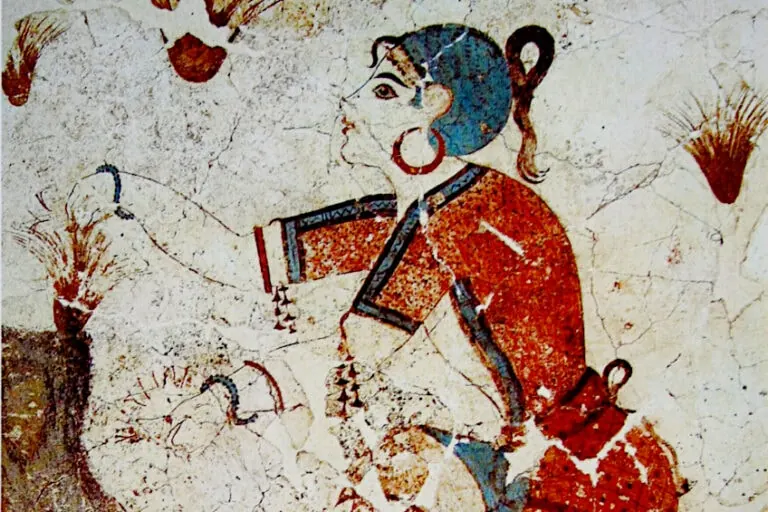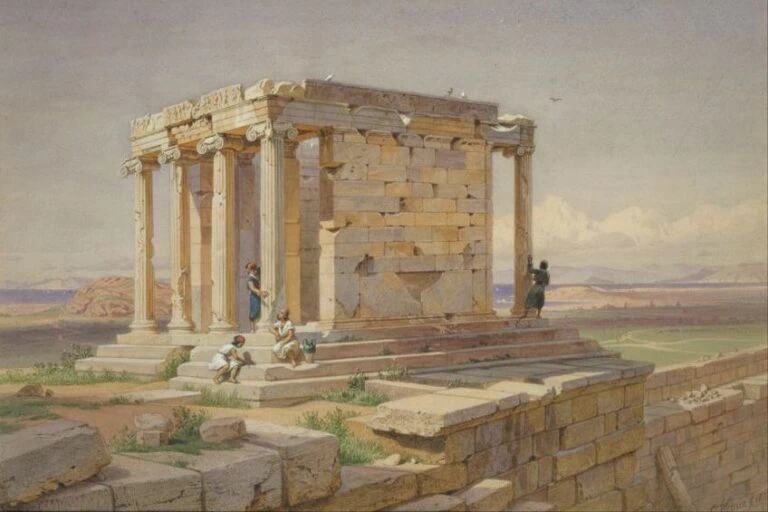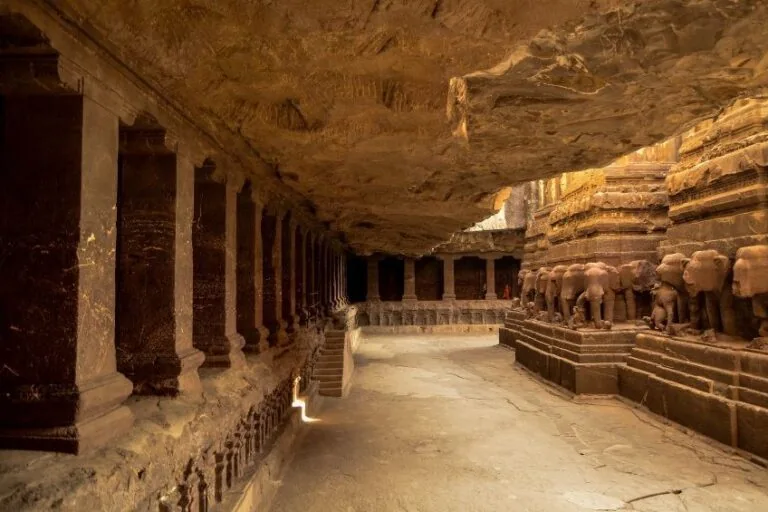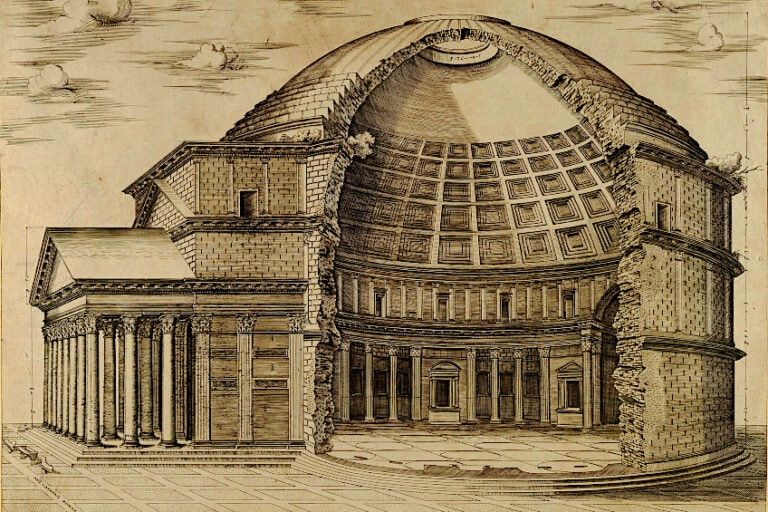What Is an Obelisk? – Exploring the History of the Obelisk
Fame is a concept that very few people throughout the history of the world have achieved. Making an impression on the hearts and minds of millions is something that only individuals at the pinnacle of prominence seem to be able to achieve. However, there are other ways to leave your mark on the world, a fact that our ancestors and the societies they found themselves part of realized. One of these ways was to create megalithic structures known as obelisks. What is an obelisk, though? Which are the most well-known? Let’s have a look at these and other commonly asked questions about these structures.
Contents
What Is an Obelisk?
While many probably think that we’ll know what an obelisk is when we see one, do we really? The widely accepted definition of an obelisk is defined as a tall, four-sided, pointed pillar that tapers inward from its base toward its top, which is usually pyramid shaped.
The term obelisk was originally coined by the Egyptians who referred to them as “tekhenu”
These structures were then adopted by the ancient Greeks who instead called these large stone structures “obeliskos”. Egypt and Rome hold the most monolithic obelisks on the face of the planet, with Egypt currently being home to around five of these structures and Rome being home to around 13, all of which are believed to have originated from Egypt.
 Part of an obelisk, king Ramesses II offering, San el-Hagar (Tanis), Egypt (1250 BCE); Roland Unger, CC BY-SA 3.0, via Wikimedia Commons
Part of an obelisk, king Ramesses II offering, San el-Hagar (Tanis), Egypt (1250 BCE); Roland Unger, CC BY-SA 3.0, via Wikimedia Commons
Obelisks that were created in the ancient world are monolithic, essentially meaning that they were created out of one piece of solid stone. This differs considerably compared to modern obelisks, as they are constructed out of separate pieces that are joined together once they have been fabricated.
Obelisks were constructed for different reasons by different cultures, but most monolithic obelisks from the ancient world were constructed by the ancient Egyptian people to represent their sun god. These obelisks are massive in size and were typically placed at the entrances to temples and other places of worship and/or prominence. As we mentioned previously, the term “obelisk” is not derived from the original word given to these structures. Instead, it is derived from a Greek word due to the traveler Herodotus’s (a Greek man) description of the objects in his writings.
As we mentioned previously, “obeliskos” is the source of modern the modern word “obelisk”, which has become synonymous with these structures, and other structures resembling it.
History of the Obelisk
The ancient Egyptians were the first to create these megalithic structures. In fact, the first known temple obelisk still exists today, measuring around 20 meters in height and weighing in at around 120 metric tons! This is known as the temple of Senusret, and was constructed entirely out of red granite under the rule of the 12th Egyptian dynasty. This obelisk is still in its original position and is located in modern-day Heliopolis, Egypt. The ancient Egyptians constructed many of these obelisks for essentially the same purpose.
According to ancient Egyptian mythology, the obelisks are meant to represent the sun god Ra.
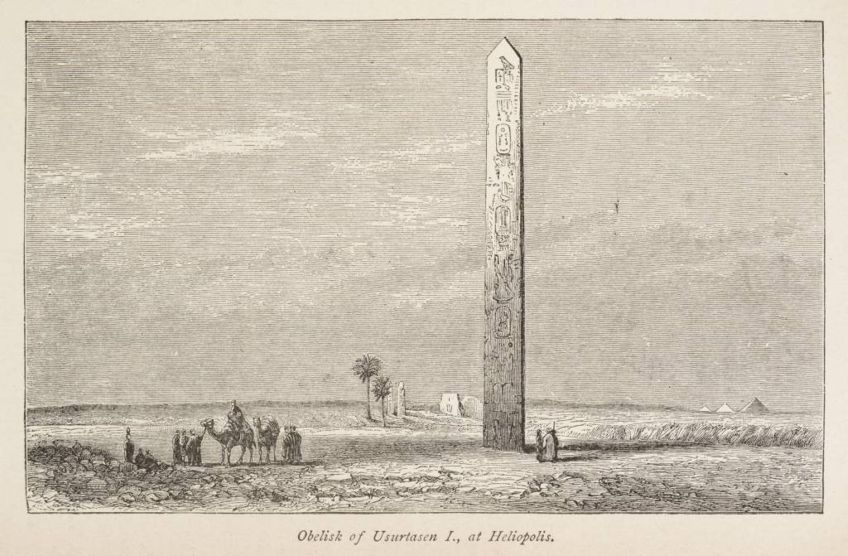 Obelisk of Usurtasen I. at Heliopolis. (1884) from A Confederate Soldier in Egypt by Dodd, Mead & Company; See page for author, CC BY-SA 2.5, via Wikimedia Commons
Obelisk of Usurtasen I. at Heliopolis. (1884) from A Confederate Soldier in Egypt by Dodd, Mead & Company; See page for author, CC BY-SA 2.5, via Wikimedia Commons
There are religious texts that note the first obelisk being constructed at Heliopolis was a petrified ray of sunlight produced from the sun disk Aten. What does this mean exactly? Well, the closest analogy would be if you were able to “freeze” or solidify a bolt of lightning, Essentially, it represents an act of God solidified, which is why the obelisk bore such significance.
There are other notable symbolisms present in the structure of an obelisk. One of the more notable of these symbolisms lies at the very top of these structures. Obelisks are known for the four-sided pyramid at their highest point, which is a representation of the Egyptian creation myth, and the god associated with it, Atum. The four-sided pyramid located at the top of the obelisks is known as the Benben. This structure is said to have risen out of the primordial liquid located where Atum once sat, resulting in the creation of life as we know it today.
It is seen as a holy symbol, so it makes sense as to why it is located at the top of these immense dedications to the god of the sun.
Obelisks of the Nubian Kings
These days, if you want to secure your position in the hearts and minds of your people as a leader, you could do some virtue signaling on social media, or create sweeping reforms to better the lives of your electors. Unfortunately for the Nubian Kings of the 12th dynasty, neither of these would secure them sufficient prominence in history. Instead, they each sought to secure their standing in history by constructing at least one obelisk over the course of their rule.
One of the more notable obelisks constructed during this period was commissioned by King Piye, who had an obelisk constructed of black granite fashioned in his honor.
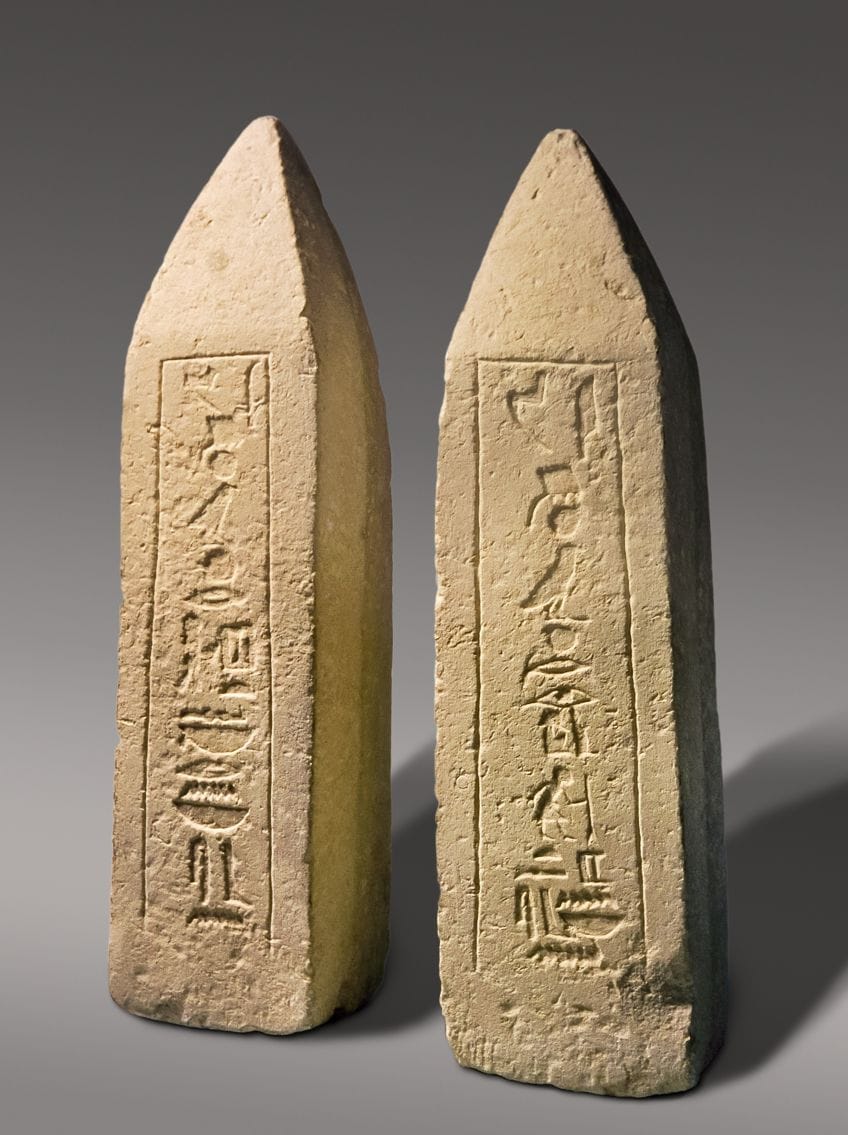 Pair of Obelisks of Nebsen (2323 – 2100 B.C.); Metropolitan Museum of Art, CC0, via Wikimedia Commons
Pair of Obelisks of Nebsen (2323 – 2100 B.C.); Metropolitan Museum of Art, CC0, via Wikimedia Commons
Unfortunately, this obelisk would not maintain its original size or shape for the rest of its existence. What is presumed by scholars to be due to the influence of the first Christian Churches in the region, the obelisk was whittled down into a simple column. This column is currently located at the National Museum of Khartoum in Sudan.
Thankfully, when this obelisk was cut down, the perpetrators managed to preserve the king’s titulary, which detailed the extent of his rule, his lineage, and his strength. Why this Egyptian obelisk was resized and/or its purpose is unknown, but we are thankful that we get to view it in this form at the very least, instead of not at all. Another Egyptian obelisk relating to the Nubian kings was found near Gebel Barkal near Khartoum.
This discovery took place in 1916 and was led by an expedition team from Harvard University, who also discovered smaller obelisks that were dedicated to the Nubian king Aktisanes.
Ancient Egyptian Obelisks and the Roman Empire
It’s pretty well known that Egypt once formed part of the Roman empire, and as a result, there were various cultural exchanges that we can identify today. Near the year 30 BCE Egypt was invaded and occupied by the Roman empire, who proceeded to raid and loot the various temple complexes in the region. One of the most famous instances of the Roman empire simply taking pieces of Egyptian history is when they destroyed the walls of the Temple of Khamak and quite literally dragged them off.
Due to this fact, there’s roughly double the number of objects taken by the Roman empire during their occupation than there are left in Egypt.
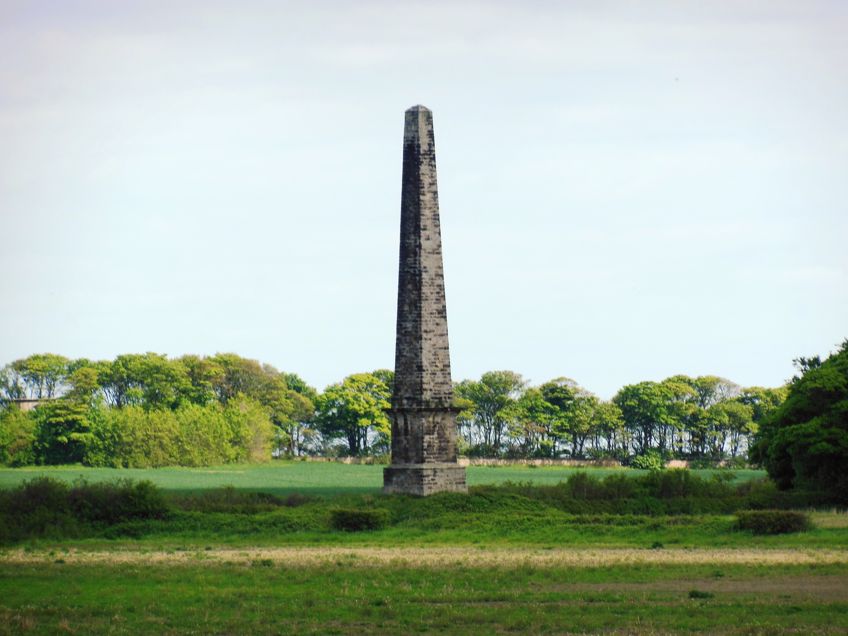 The Obelisk Seaton Valley (1718); The Obelisk by Bill Henderson, CC BY-SA 2.0, via Wikimedia Commons
The Obelisk Seaton Valley (1718); The Obelisk by Bill Henderson, CC BY-SA 2.0, via Wikimedia Commons
Once the obelisks were removed from their original locations they were shaped off various places all over the world. This took place around 1700 years ago, and many Egyptian obelisks can be found all over the world today. However, there are still many obelisks that remain inside Egypt today.
The Lateran Obelisk
The largest of the obelisks that were taken during this period is called the Lateran obelisk. It is located near a cathedral named Lateran Basilica and stands at around 32 meters in height, and weighs around 455 tons. While this is by far the largest obelisk taken by the Roman empire, it isn’t the best-known one. The most well-known obelisk in Rome is the one located in Saint Peter’s Square. Even though this obelisk is only 25 meters in height and weighs 331 tons, it is one of the most prominent locations in Rome, which is what has afforded it its fame.
This obelisk was brought to Rome under the orders of Emperor Caligula.
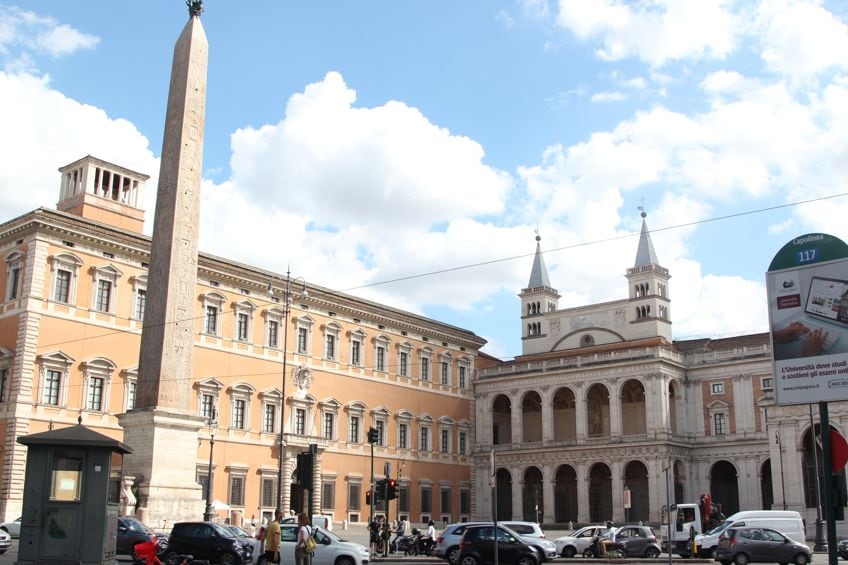 The Lateran Obelisk (1400 BCE); Fallaner, CC BY-SA 4.0, via Wikimedia Commons
The Lateran Obelisk (1400 BCE); Fallaner, CC BY-SA 4.0, via Wikimedia Commons
The arrival of this obelisk was quite the occasion in ancient Rome as mentioned by Pliny the Elder in his book Natural history. Apparently, the barge used to transport the artifact was so large that fir wood masts used to secure it could not be hugged by the arms of four men! The barge itself would later be filled with cement and sunk to the bottom of the ocean as no other use could be found for it. To really drive home how big this barge was, once it was sunk to the bottom of the ocean it was actually used to form the foundation of a quay that would then become part of the new harbor at Ostia.
The amount of manpower and ingenuity it would have taken to transport this obelisk to its current location would have been extraordinary.
Erection of Lateran Obelisk
The erection of the obelisk was a sight to behold. The elected pope of the time known as Pope Sixtus V was intent on having the unit erected in front of St. Peters, which at this point in time had finished construction. The obelisk’s erection was entrusted to one Domenico Fontana, who inevitably got the job done. To illustrate just how he intended to get the job done, Fontana created a little wooden crane and a miniature obelisk made of lead with which to show the pope exactly how he intended to erect the structure in the square.
The model was fully functional and included a little winch mechanism by which the pope could raise and lower the obelisk by turning a little wheel.
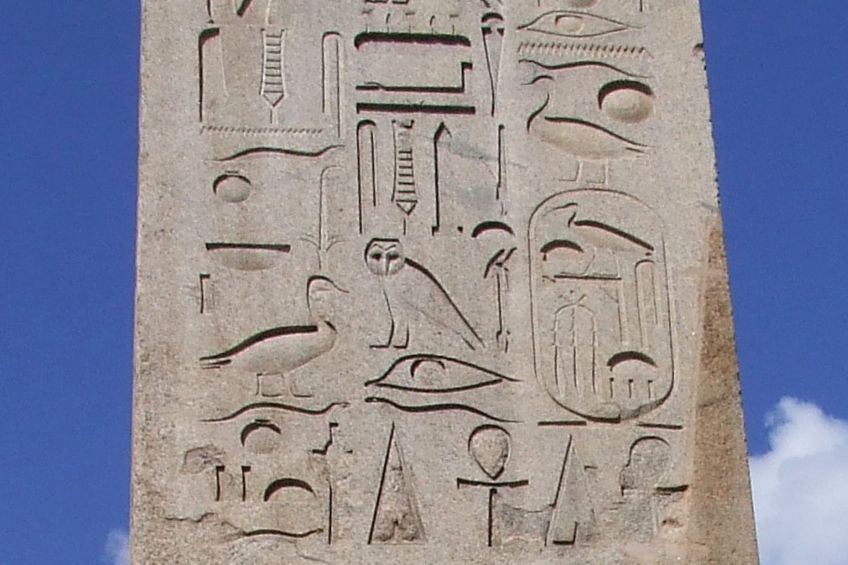 The Lateran Obelisk (1400 BCE); Lateran_obelisk._Base_of_obelisk_with_citatation_of_Emperor_Constantine.JPG: Laurel Lodgedderivative work: JMCC1, Public domain, via Wikimedia Commons
The Lateran Obelisk (1400 BCE); Lateran_obelisk._Base_of_obelisk_with_citatation_of_Emperor_Constantine.JPG: Laurel Lodgedderivative work: JMCC1, Public domain, via Wikimedia Commons
The obelisk stood idle for a while, but would eventually be erected where it stood to be moved to the piazza. This took considerable effort not only logistically, but in terms of manpower as well. How much manpower, you ask? It took 1000 men 17 days to move the obelisk to its intended location, besides the 47 cranes and 140 tow carts. Once the obelisk was in position, it was scheduled to be re-erected on the 17th of September in St. Peters Square, where it would be watched by a massive crowd. This wasn’t due to the awe of watching the obelisk being lifted alone, as the day would coincide with the feast of the cross for this year.
This was an incredible feat of engineering that put Fontana on the map, not only as a visionary engineer but as a planner and man of prominence overall. This exercise was so intricate that Fontana actually wrote a book that included painstakingly intricate notes and illustrations regarding the planning and execution of the obelisk’s erection.
It would seem that Fontana did anticipate the margin for error though, as it is rumored that before the obelisk was due to be lifted, he had arranged for several horses to be placed in relay, should he be in need of a quick escape. Since this would have no doubt resulted in sizable debts and embarrassment, it is completely understandable. Fontana’s book is arguably one of the most influential pieces of engineering literature in recent history. Named “Della Trasportatione dell’Obelisco Vaticano et delle Fabriche di Nostro Signore Papa Sisto V “, it was published in 1950 and is still a work of prominence in a historical sense.
Once the Obelisk was erected in the square, the artifact was exorcised. At this point, the Basilica was nearing completion, but since the obelisk was a key reference point, the nave of the church had to be kinked slightly to ensure that it lined up with the obelisk perfectly, resulting in the iconic look of the square we know today!
Other Obelisks Located in Rome
Although the obelisk in St. Peters square is arguably the best known internationally, there were a few other obelisks erected around Rome during the reign of Pope Sixtus. There were three more obelisks to be exact, one was erected at Santa Maria Maggiore all the way back in 1587, another was erected a year later at Lateran Basilica, and yet another the following year in the Piazza del Popolo (also known as the people’s square).
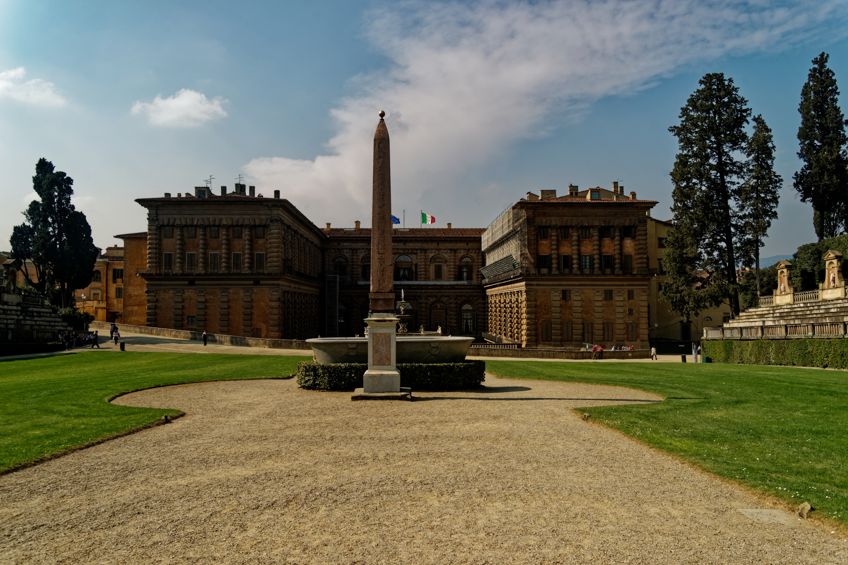 Firenze – Florence – Giardino di Boboli – View NNW on Egyptian Obelisk (moved from Villa Medici here in 1790); Txllxt TxllxT, CC BY-SA 4.0, via Wikimedia Commons
Firenze – Florence – Giardino di Boboli – View NNW on Egyptian Obelisk (moved from Villa Medici here in 1790); Txllxt TxllxT, CC BY-SA 4.0, via Wikimedia Commons
Other notable (but smaller) obelisks located in Rome are also associated with churches. Notably, the one located in front of the Spanish steps at Trinità dei Monti, and another that was erected at the Villa Medici. The latter was later relocated to Boboli Gardens (near the famous Pitti Palace), but the Medicis filled the space left empty at their villa with a replica.
Obelisks of the Roman Empire
It’s easy to forget that Rome and its culture were present far outside far beyond its sovereign borders thanks to their empire at some point. As a result, regions under the empire’s control often sported their very own obelisks, often in an attempt to emulate the aesthetic and air of importance their artifacts seemed to carry with them.
A good example of this is when Herold the Great erected an obelisk made of red granite in his city of Caesarea (modern-day Israel). The obelisk was not nearly as large or as heavy as some of the others we have covered so far, weighing in at only 100 metric tons, and only being around 12 meters in height.
While they might not be among the most famous obelisks, the two that were sent down the Nile to the city of Alexandria by Emperor Constantius the second are still pretty notable. These obelisks were taken to commemorate his reign of over two decades, which he sought to celebrate by sending one to Rome (which would later be known as the Lateran obelisk) and the other would be sent to modern-day Istanbul which would stand in their hippodrome.
Ancient Obelisks Around the World
There are quite a few other famous obelisks around the world whose creations are attributed to other ancient societies. This being said, let’s have a look at some famous ancient obelisks around the world, where they are located, why they were built, and why they tend to draw a crowd in the modern day.
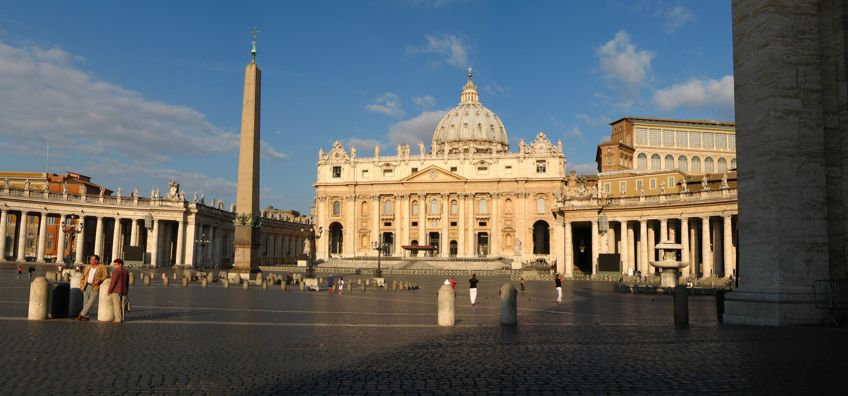 The Vatican Obelisk (37 AD); Photograph by Greg O’Beirne, CC BY-SA 3.0, via Wikimedia Commons
The Vatican Obelisk (37 AD); Photograph by Greg O’Beirne, CC BY-SA 3.0, via Wikimedia Commons
Obelisks of the Assyrian Civilization
While Egyptian obelisks might be better known, there were quite a few obelisks constructed by the Assyrian people too. The Assyrian people lived in Mesopotamia, where they thrived in city-states, territories, and eventually a sprawling empire! They produced obelisks to commemorate the rule and achievements of their rulers.
Assyrian obelisks were similar to those produced by the ancient Egyptians, and just like Egyptian obelisks, they can be found all over the world. Some of the better known of these obelisks are currently in the possession of the British Museum.
The White Obelisk
The White Obelisk of Ashurnasirpal was found in what is now Modern day Iraq by Assyriantologist Hormuzd Rassam who discovered the obelisk Nineveh (modern-day Mosul). The obelisk was erected by an Assyrian ruler to commemorate his rule over the people, the goods he seized, the herds of livestock he controlled, as well as hunting, great feasts, and of course, war campaigns during his rule. These are all typical features and narratives associated with Assyrian obelisks of the time.
 Neo-Assyrian Limestone White Obelisk of Ashurnasirpal I, Nineveh, (1049-1031 BC); Gary Todd, CC0, via Wikimedia Commons
Neo-Assyrian Limestone White Obelisk of Ashurnasirpal I, Nineveh, (1049-1031 BC); Gary Todd, CC0, via Wikimedia Commons
The Broken Obelisk
Two other broken/ fragmented obelisks were discovered in the region as well. Hormuzd Rassam discovered and named the Rassam Obelisk in another Assyrian citadel named Nimrud, but these days there isn’t much but fragments that remain of it.
This would later be reconstructed thanks to the efforts of the British Museum and is believed to be the oldest obelisk found to have been produced by the Assyrian people.
The Black Obelisk
Sir Austen Henry Layard discovered what has come to be known as the black obelisk all the way back in 1846, which he first laid eyes on in the Kulhu, a citadel of the ancient Assyrian people. The erection of the black obelisk is attributed to Shalmaneser III who immortalized his subjugation of other rulers on the obelisk’s glyphs and added an extract from his annals to it for good measure.
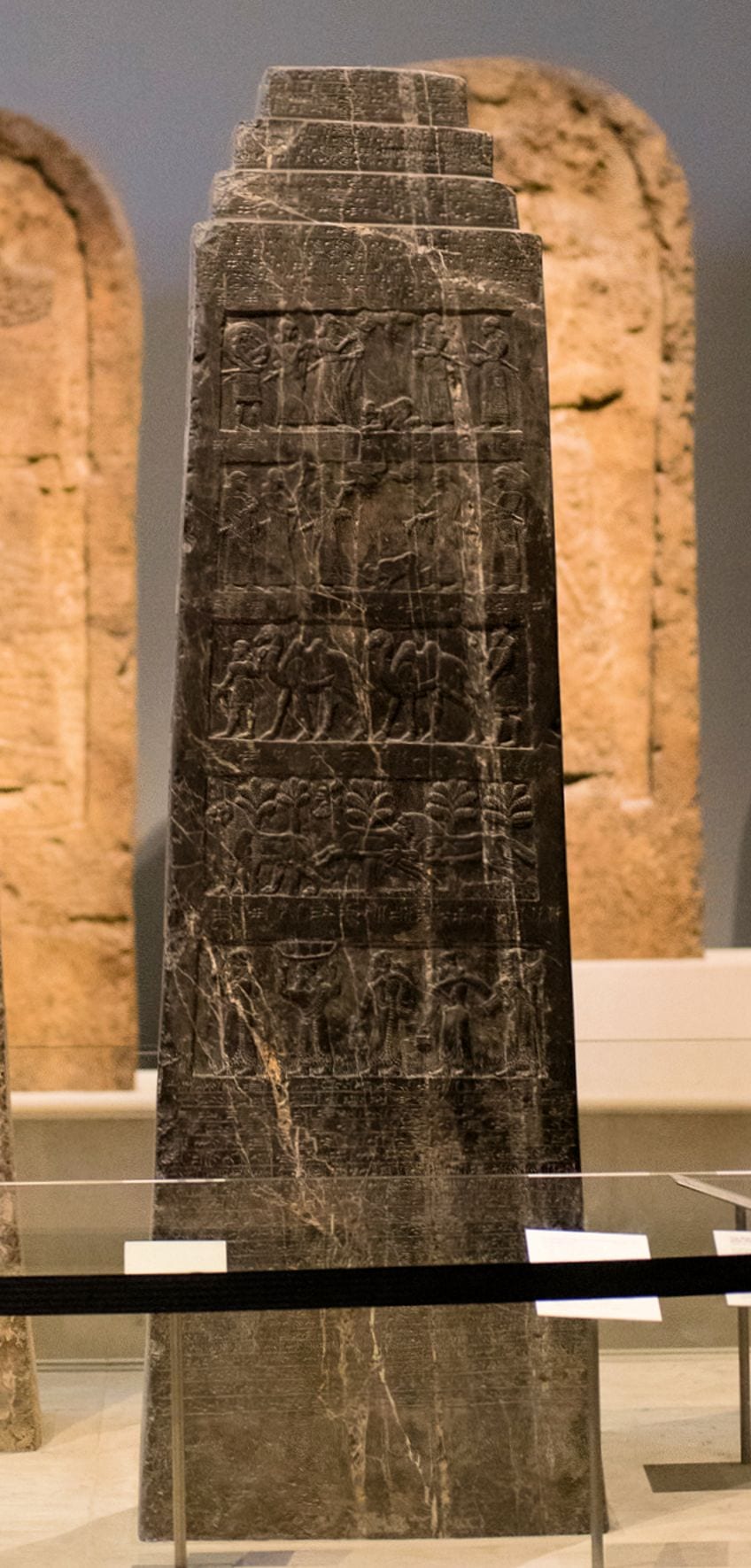 The Black Obelisk (c. 850 BCE); Paul Hudson from United Kingdom, CC BY 2.0, via Wikimedia Commons
The Black Obelisk (c. 850 BCE); Paul Hudson from United Kingdom, CC BY 2.0, via Wikimedia Commons
Obelisks of the Ethiopian (Axumite) People
The ancient kingdom of Axum was home to many obelisks that were constructed (and subsequently erected) by the Axumite people. Today, the region is known as Northern Ethiopia and was the birthplace of the only unbroken obelisk constructed in this era known as the King Ezana’s Stele, which stands at 21 meters high.
Paired with it in notoriety is arguably the most famous obelisk from the region called the Obelisk of Axum. This behemoth stands a staggering 24 meters in height and is believed to have been created all the way back in the 4th century CE.
Unfortunately, due to erosion, it would eventually collapse and be found by Italian forces in the mid-1930s. Due to the conflict between the Axum people and Italian forces, the three fragments of the obelisk were looted and shipped back to Rome around the year 1937. The obelisk was reconstructed and erected in Piazza di Porta Capena, where it stood as a monument of conquest for many years.
Return of the Axum Obelisk
In recent years there has been quite a bit of controversy surrounding artifacts that have been looted by colonial nations. Social and societal pressures have resulted in many artifacts that bear religious and cultural significance being returned to their cultures and people of origin, and the Axum obelisk was one of them!
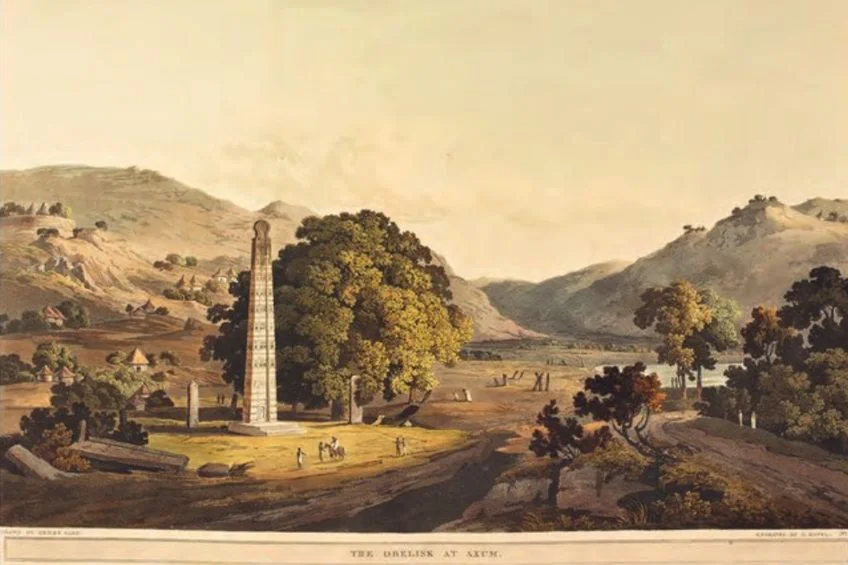 The Obelisk at Axum (1809) by Salt and Havell; Henry Salt and Daniel Havell, Public domain, via Wikimedia Commons
The Obelisk at Axum (1809) by Salt and Havell; Henry Salt and Daniel Havell, Public domain, via Wikimedia Commons
After years of litigation and a back-and-forth battle between various parties and the Italian government, the obelisk was eventually returned and re-erected in Northern Ethiopia in 2008. This was a great victory in the ongoing quest of many nations who sought looted and smuggled artifacts to be returned to their rightful homes by former colonial powers.
Now that you know what an obelisk is, the history of the obelisk, what an obelisk usually represents, the difference between a monolithic obelisk and a segmented one, and the different cultures around the world who created obelisks, it’s time for you to get out there and put your newfound knowledge to the test! Obelisks are quite a sight to behold, and we highly recommend checking one out should you have the opportunity.
Frequently Asked Questions
What Does an Obelisk Represent?
Obelisks are found all over the world, but what does an obelisk represent? Usually, an obelisk stands as a monument to the achievements and reign of a ruler. This is why they’re often found with glyphs or pictographs detailing campaigns of war, subjugation, and power. Essentially, it is a show of power, wealth, and ingenuity.
Why Are Obelisks Everywhere?
Obelisks have been found in ancient societies in Egypt, Mesopotamia, and even Ethiopia. Why are obelisks everywhere, though? Well, rulers of large ancient societies often built them to immortalize their reign, and when their lands were conquered or colonized, some of these artifacts were taken all over the world as spoils of war.
Who Created the First Obelisk?
It is widely believed that the history of the obelisk began with the ancient Egyptian people. The obelisk shape is attributed to their sun god, and the pyramid-like head of the obelisk shape is attributed to their god of creation, both being Atum.
What Is An Obelisk?
Most of us would like to think that we’d know an obelisk if we saw one, but what is an obelisk? The most commonly accepted definition of an obelisk is a tapering stone pillar usually with a rectangular body and pyramid shape at the very top. These are usually quite tall and built as displays of power and/or conquest of a leader.

I am deeply passionate about history and am constantly fascinated by the rich and complex stories of the past. As the editor-in-chief of learning-history.com, I have the opportunity to share this passion with a wide audience through the creation and distribution of engaging and informative content about historical events, persons, and cultures. Whether it’s through writing articles and blog posts or creating videos or podcasts, I strive to bring the past to life in a way that is both accurate and enjoyable. My expertise in history, combined with my strong writing and communication skills, allows me to effectively communicate complex historical concepts and make them accessible and interesting to a wide range of readers. I am truly grateful for the opportunity to share my love of history with others through my work on learning-history.com.

